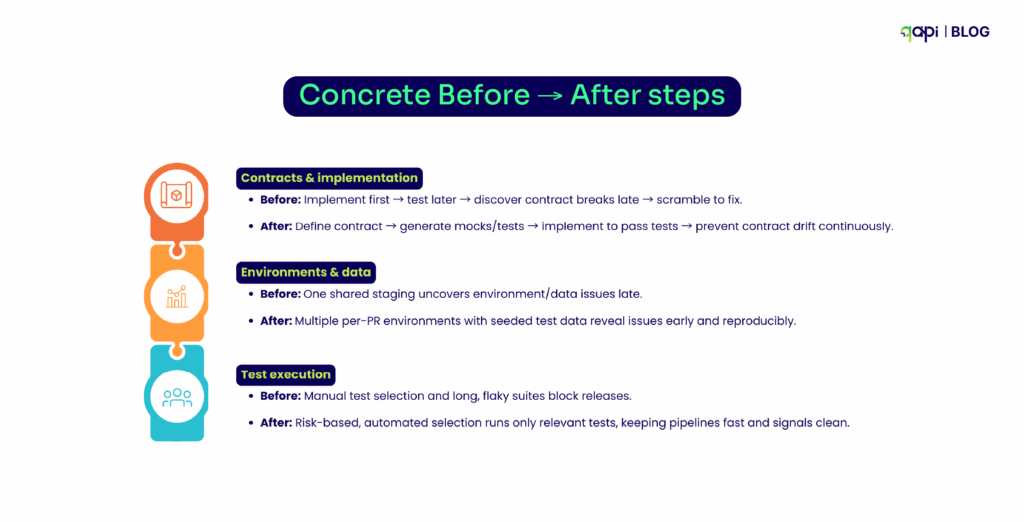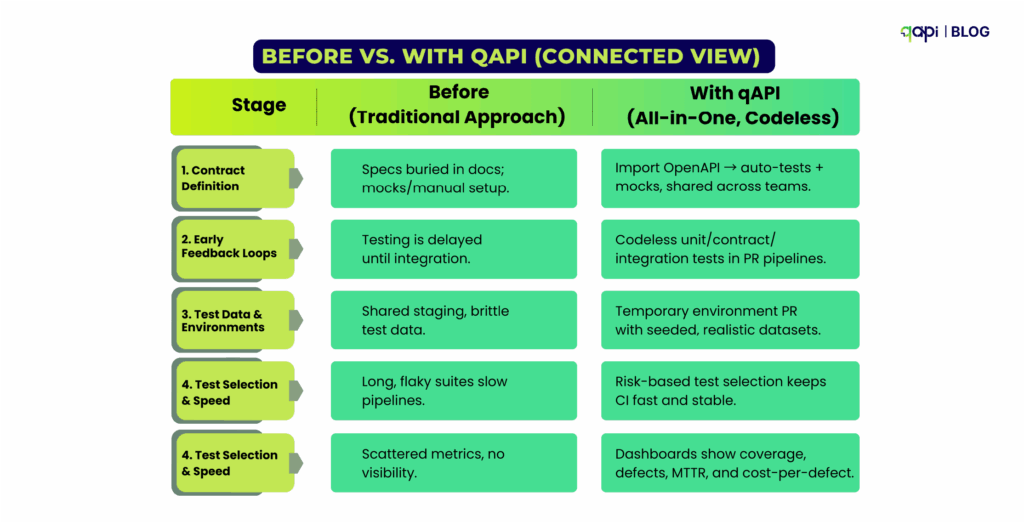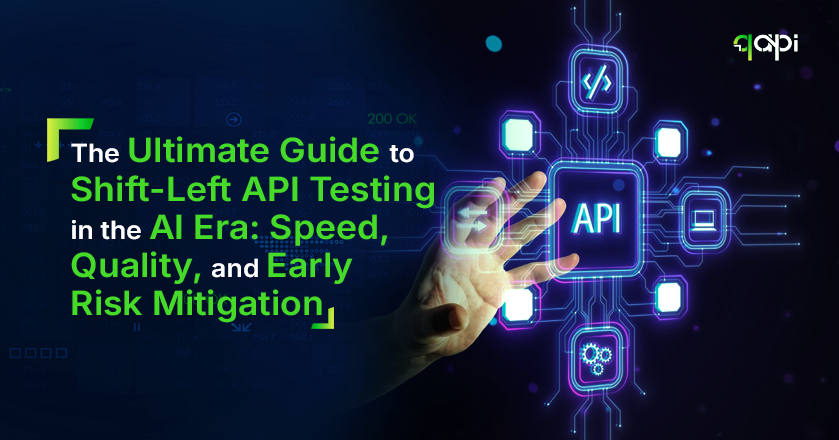There was a time when API testing sat quietly at the end of the release cycle—treated like a final checkpoint rather than a strategic advantage. Developers shipped code, testers scrambled to validate integrations, and deadlines slipped because bugs were discovered too late.
But everything changed the moment AI entered the SDLC.
Across the globe, nearly 90% of testers now actively seek tools that can simplify and accelerate their API testing workflows. Not because testing suddenly became harder—but because expectations skyrocketed. Today’s teams are expected to ship faster, catch defects earlier, and deliver flawless digital experiences—all at once.
That’s where AI-powered Shift-Left API testing emerges as a game-changer.
Testing tools today aren’t just passive listeners capturing requests and responses. They’re becoming intelligent co-pilots—learning from previous test patterns, suggesting assertions automatically, generating test suites from documentation, predicting failure points, and even self-healing scripts when APIs evolve.
In short: AI isn’t just improving testing—it’s rewiring how teams think about quality.
And if you’re still treating API testing as a post-development activity, you’re already behind.
The good news? Shifting left doesn’t have to be complex. Whether you’re starting from scratch or optimizing an existing pipeline, here are practical steps to immediately level up your API testing game—and build an SDLC that’s faster, smarter, and future-ready.
What Is Shift-Left API Testing and Should You Plan for It?
Shift-left API testing is all about starting to test and validate in the design and coding phases, rather than waiting for QA handoffs or production deploys.
For developers, it means writing testable APIs from day one; for testers and QA, it’s about collaborating early to define expectations and automate checks.
In simple words, by shifting left you can prevent defects upstream to avoid downstream disasters in your distributed architectures.
We asked some people on how they see this change and here’s what they had to say:
From the Developer’s Desk: “Shift-left API testing means I’m writing tests alongside my API code, not after deployment. It’s about catching breaking changes before my teammates do—which saves everyone’s energy and our sprint goals.”
From the Tester’s Perspective: “Instead of being the security guard at the end, I’m now a collaborator from day one. Shift-left means I’m helping define what ‘working’ means before a single line of API code gets written.”
From the QA Leader’s View: “We’ve seen a 67% reduction in production incidents since implementing shift-left API testing. It’s not just blind faith—it’s actually essential for our teams to ship daily in microservices architectures.”
So, why is “shifting-left” crucial in Agile/DevOps teams today?
Overall, the thrust of your development strategy has changed.
Now it’s way too in the past where developers write code over the wall; now there’s shared ownership from the start. Why now? Because APIs are now at the heart of almost everything, from mobile backends to cloud services, early validation ensures reliability in complex ecosystems.
To ensure it easily happens in Agile and DevOps teams, shift-left is crucial because it aligns with fast iterations—gives continuous feedback loops that keeps everyone on the same page.
Google searches for “shift-left API testing” keyword/query have risen to 45% year-over-year, clearly showing the push for early validation in automation trends. Here’s why
1️⃣ Agility only works with early truth. Agile workflows today are designed to shorten planning cycles, but if critical defects surface late in the pipeline, it’s like moving in speed but in circles. Shift-left gives developers an “early preview” of contract alignment, reality, and performance/security checks while the code is still fresh in their heads.
2️⃣ DevOps needs confidence to automate. Continuous delivery pipelines are only as trustworthy as the signals that feed them. If tests are not well thought through or feedback is delayed, teams will be unsure before moving to production. API testing gives that confidence (unit, contract, and policy-as-code checks) to move forward with automation.
3️⃣ It redefines cost beyond dollars. The cost of late defects isn’t just rework—it’s delayed features, lost trust in CI/CD, and mental overhead from reworking everything. Early detection reduces your workload, keeps teams focused on new value delivery, and builds a culture of proactive ownership.
4️⃣ The left-right loop should be balanced. Shift-right is all about observability, feature flags, error budgets but those signals are only useful if they are implemented(yes, I already mentioned this). Shift-left API testing ensures those learnings don’t just sit in dashboards—they become guardrails that prevent repeat incidents.
Build Authority Through Testing: From Waterfall to Shift-Left
Once again, do you remember the old days when your teams used to say
Developer Experience: “In the old model, I’d spend weeks building an API, only to discover integration issues during system testing. The feedback loop was brutal—sometimes 2-3 weeks between writing code and knowing if it actually worked.”
Tester Challenges: “We were always the bottleneck. Receiving complex APIs with no context, trying to understand business logic through trial and error, and finding critical issues when there was no time to fix them properly.”
QA Leadership Struggles: “Late-stage defects cost 10x more to fix than early-stage ones. We were fighting fires instead of preventing them, and our teams were burning out from constant crisis mode.”
So, if you and your teams are still having these conversations, you need to start implementing on shortening the loop.
Waterfall: How It Used to Work
In old-school waterfall development, testing came at the very end of the process:
• Up-front lock-in: Requirements and design were finalized early, with little room for iteration.
• Late validation: Developers coded for weeks before handing off to testers.
• Surprise failures: Cross-service and contract issues surfaced late in system testing, often close to release.
• Slow, costly cycles: Feedback took weeks, defects were expensive to fix, and hotfixes or rollbacks became common.
The result? It’s pretty clear that teams, product developers, and users were all unhappy.
Shift-Left: How It Works Today
A good API development plan doesn’t have to be long. But it should be clear and driven by real outcomes, from the very start of development:
• Contracts first: Teams should define or refine OpenAPI specs, set acceptance criteria, and align on contracts before coding begins.
• Collaboration in flow: Developers and testers work together on unit, contract, and integration tests that run locally and on every pull request.
• Smarter pipelines: CI/CD gates run in layers—fast checks (unit, contract) first, followed by targeted integration, performance, and security tests. Feedback arrives in near real time, and you are back on track
This creates a proactive loop where issues are prevented, not just detected.

Concrete Before → After Steps
• Contracts & implementation
• Before: Implement first → test later → discover contract breaks late → scramble to fix.
• After: Define contract → generate mocks/tests → implement to pass tests → prevent contract drift continuously.
• Environments & data
• Before: One shared staging uncovers environment/data issues late.
• After: Multiple per-PR environments with seeded test data reveal issues early and reproducibly.
• Test execution
• Before: Manual test selection and long, flaky suites block releases.
• After: Risk-based, automated selection runs only relevant tests, keeping pipelines fast and signals clean.
The Benefit of Shifting Left: Speed, Quality, and Cost
• Faster Defect Detection and Lower Cost to Fix: Catch bugs during coding, not QA. Studies show shift-left reduces defects by 60-80%, slashing fix costs easily.
• Better Code Quality and Reliability: Developers get instant feedback via automated tests, leading to robust APIs. Testers focus on exploratory work, boosting overall reliability in distributed apps.
• Accelerated Release Cycles: With CI/CD integration, releases go from weeks to hours. For instance, teams can cut cycles by 70% using qAPI’s shift-left automation.
• Improved Collaboration Between Developers, Testers, and Stakeholders: qAPI helps teams share access so everyone is in on the developments everyone makes and can contribute simultaneously.
How to Embed Shift-Left API Testing—Best Practices for 2025
Shift-Left API Testing Starter Pack
You’ve seen the “why.”
Here’s the “what to do next” — see how qAPI makes each step easier by giving you one end-to-end, codeless platform where tests, data, environments, and results live in one place.
Step 1: Pick One API and Make It Bulletproof
What to do: Choose your most important API. Define clear “contracts” (rules of behavior). With qAPI: Upload your OpenAPI spec → qAPI instantly generates tests + mocks for dev and consumer teams. Result: Contract drift is caught immediately, not in production.
Step 2: Get Fast Feedback on Every Change
What to do: Run lightweight tests every time code changes. With qAPI: All test types (unit, contract, integration, security) run automatically in CI/CD. No coding needed. Result: Developers know within minutes if they broke something.
Step 3: Test in Realistic Environments
What to do: Use data and environments that feel like production. With qAPI: Spin up temporary PR environments with safe, realistic datasets qAPI lets you choose as many virtual users as you want so you’re in control at each step. Result: Integration issues surface early and can be reliably reproduced.
Step 4: Test Smart, Not Everything
What to do: Don’t waste time running every test on every change. With qAPI: Risk-based selection runs only relevant tests, while still covering critical paths. Result: Pipelines stay fast, signals stay clean, so does your Jira.
Step 5: Prove It’s Working
What to do: Track improvement over time. With qAPI: Built-in dashboards show bug escape rates, MTTR, coverage, and release velocity. Result: Leadership sees ROI in months, not years.
Now along this path, you’re sure to have some problems along the way.
Top 5 Problems You Might Face (and How to Fix Them)
1️⃣ Tests take too long to run
• Fix: Focus first on the most critical APIs and run only essential tests on each change. You can run parallel tests if needed.
2️⃣Team resists adopting new testing practices
• Fix: Start small with one API or feature, demonstrate quick wins, and gradually expand. Show how easy, simple and streamlined it can be.
3️⃣Tests break frequently or are unreliable
• Fix: Use qAPI’s test case generation to automatically write new tests when minor changes occur, so you’re just clicking and saving time. Rather than thinking and writing code.
4️⃣Learning curve is too steep
• Fix: Take advantage of qAPI’s codeless interface—no programming is needed to create and run tests.
You can get used to it in no time.
5️⃣ Current tools don’t integrate well
• Fix: Connect qAPI to your existing CI/CD pipelines and tools so testing fits into your workflow seamlessly.
Before vs. With qAPI (Connected View)

Most guides explain what shift-left is. This one shows you how to actually do it—with qAPI as the single place to plan, run, and track every test type, without writing code.
Next step: Pick one API and run Step 1 in qAPI. You’ll see measurable results in your first week.
Act today.
I’ve seen teams build applications, products and services for startups and companies, and no matter the industry size and budget, the best ones start with one thing.
Clarity/Vision.
Clarity stands about what you’re trying to achieve, Vision is all about how you’re approaching it.
So, if you’re building your own, don’t aim for perfection. Look for impact. And build something that is making a difference, but before that, test it.
FAQs
Start small by picking a critical API, defining its contract (OpenAPI/Swagger), and adding automated tests early in development. Use tools like qAPI to run codeless unit, contract, and integration tests in your CI/CD pipeline.
Yes. Wrap legacy APIs gradually with contracts, run automated tests against them, and integrate into PR-level pipelines. Start with new or high-impact endpoints first, then expand coverage.
Look for tools that support codeless test creation, contract-driven testing, and CI/CD integration. Examples include qAPI it can integrate any API collection like Postman, and Swagger. Prioritize tools that let you run all tests in one place and generate reusable mocks.
Not at all. They complement each other. Shift-left catches issues early in dev, while shift-right validates real-world behavior with feature flags, canary releases, and monitoring. Combining both creates a full quality loop, reducing production bugs and rollbacks.

